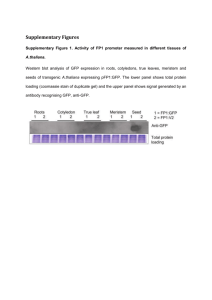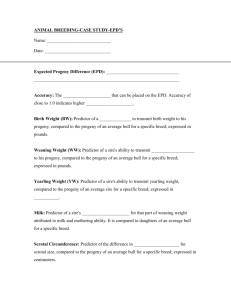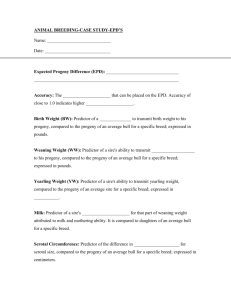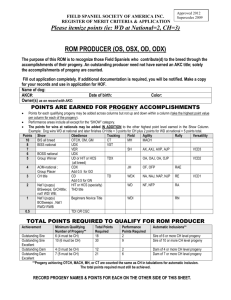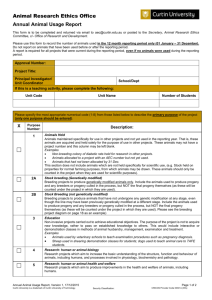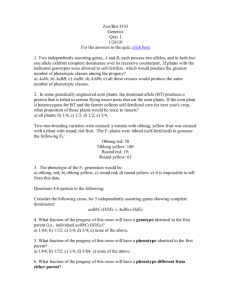2409.26g_70 - USDA Forest Service
advertisement
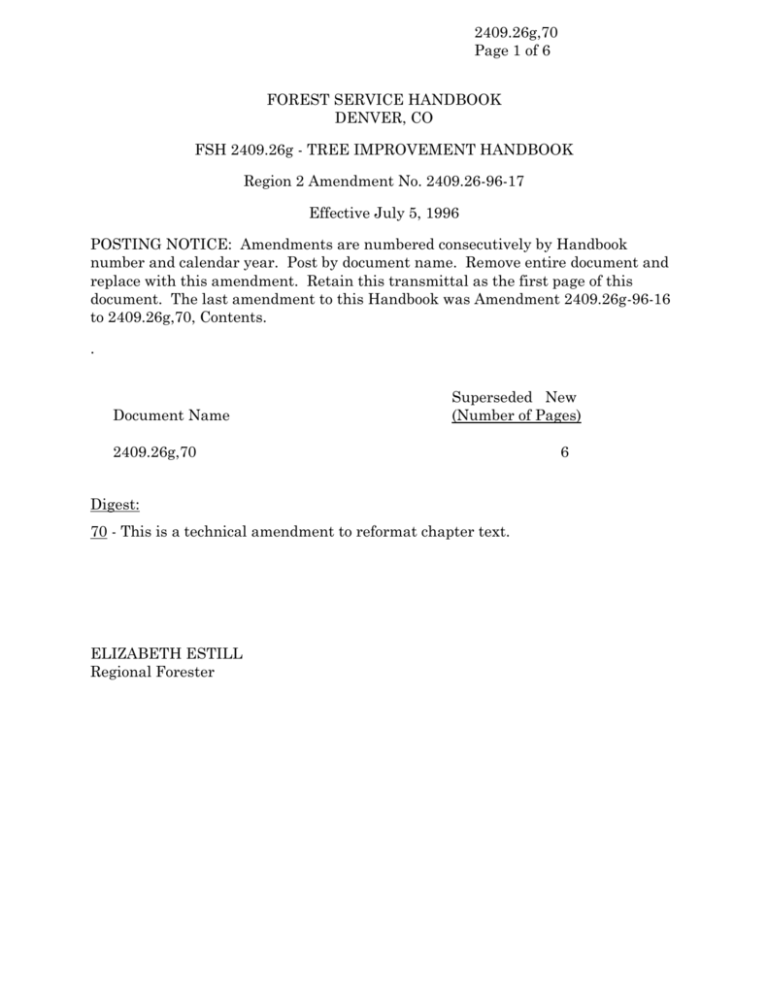
2409.26g,70 Page 1 of 6 FOREST SERVICE HANDBOOK DENVER, CO FSH 2409.26g - TREE IMPROVEMENT HANDBOOK Region 2 Amendment No. 2409.26-96-17 Effective July 5, 1996 POSTING NOTICE: Amendments are numbered consecutively by Handbook number and calendar year. Post by document name. Remove entire document and replace with this amendment. Retain this transmittal as the first page of this document. The last amendment to this Handbook was Amendment 2409.26g-96-16 to 2409.26g,70, Contents. . Document Name Superseded New (Number of Pages) 2409.26g,70 Digest: 70 - This is a technical amendment to reformat chapter text. ELIZABETH ESTILL Regional Forester 6 R2 AMENDMENT 2409.26g-96-17 EFFECTIVE 7/5/96 2409.26g,70 Page 2 of 6 FSH 2409.26g - TREE IMPROVEMENT HANDBOOK R2 AMENDMENT 2409.26g-96-17 EFFECTIVE 7/5/96 CHAPTER 70 - PROGENY TESTING All individuals selected on the basis of phenotype must be tested for estimation of their genotype (genetic constitution) and ability to transmit their desirable traits to their progeny. Testing to determine genetic quality is necessary because phenotype is the product of the interaction of the genotype of an individual and its environment. Similar phenotypes do not necessarily have similar progeny. Consequently we must be able to determine, through testing, which selected phenotypes are genetically desirable and should be retained and used in tree improvement programs. Estimates of the genetic value of selected phenotypes can be determined from data obtained from evaluation plantations. These plantings are designed to: (1) minimize environmental differences from one location to another in the planting and (2) replicate treatments (growing seedlings from one seedlot at different locations in the plantation), which permits us to evaluate and measure those environmental differences within the planting that we have not been able to eliminate despite use of good cultural treatments. It is imperative that evaluation plantings be well designed and the best available cultural treatments are utilized to minimize planting stress because some types of stress tend to mask genetic variation and negate our ability to assess the genetic value of selections. In an evaluation planting, the genetic value of selections is determined by comparing the growth of their progenies in a relatively uniform environment. This type of testing is more reliable than trying to assess the genetic value of selections growing in their highly variable natural environments. Testing of selections may be repeated in several locations to sample a range of environments for estimation of interaction between environments and genotypes. 71 - OPEN-POLLINATED PROGENY TESTS. Initial tests of superior tree selections shall be composed of progenies produced from seed collected from the selected individuals (open-pollinated seed). 71.1 - Number of Open-Pollinated Progenies. Each individual open-pollinated progeny test should include progenies from as many superior tree selections as possible. Ideally, each open-pollinated progeny test should include progeny from all superior tree selections per species per selection program. However, availability of open-pollinated seedlings from some selections, land for testing, and funding may limit the number of selections to be progeny tested at any particular location. For efficiency in planting establishment, maintenance, and evaluation each test should include a minimum of 75 open-pollinated progenies. 71.2 - Controls. Seedlings from current production seedlots from the same seed zones in which the superior tree selections have been made shall be included in each progeny test as controls. It will be desirable to have a minimum of two control sources in each test planting. The maximum number of control seedling groups in a R2 AMENDMENT 2409.26g-96-17 EFFECTIVE 7/5/96 2409.26g,70 Page 3 of 6 single planting shall be five. Control seedlings shall be included in the test planting and may also be included in the border (buffer) rows. 71.3 - Number of Progeny Test Plantings. To the maximum extent possible, each superior tree selection should have its progeny tested at a minimum of two locations established within the same breeding zone in which the parent selections have been made. If all selections to be tested are from the same seed zone, then a minimum of two progeny tests should be established within that same seed zone. The total number of progeny tests to be established within a breeding zone will depend on long-term objectives, land, staffing, and funding available for testing. 71.4 - Test Design. Generally, Region 2 will use a randomized, complete block design with multiple-tree row plots (2 to 10 trees per plot) and several replications (4 to 10) for open-pollinated progeny tests. Spacing between trees within rows and between rows will vary depending on species, objectives, availability of land, funding, etc. Trees from control sources shall be represented in each test replication. Each progeny test will be surrounded by two border (a buffer) rows. These rows help to minimize exterior environmental effects (air movement, precipitation, temperature) and provide competition to trees located on the test perimeters. A planting design for an open-pollinated progeny test with 300 seed sources (progenies and controls), 4-tree linear plots, 10 replications, and two border rows is diagrammed in Exhibit 1. This type of design with a 6 x 6 foot spacing and a 20-foot access around the planting would require about 12 acres. Each tree in the test, including controls, shall be staked. A label showing identity of the tree and location in the planting shall be attached to each stake. Staking and labeling should be checked annually and replaced, if necessary. Immediately after planting, a map showing identity and location of trees in the planting shall be prepared for inclusion in the Establishment Report. 72 - SEEDLING PRODUCTION AND CARE. Progeny test seedlings will be grown as container stock to minimize differences in environmental influences on the seeding during production and to ensure production of seedlings of adequate size, relative uniformity, and proper physiological conditioning prior to test establishment. Progeny test seedlings will be grown under cooperative agreement with another Federal or State agency, or under contract with private industry. Very specific production, handling and quality criteria must be included in the cooperative agreements or contracts for these seedlings. Seedling production and handling will need to be carefully monitored; and Regional, Forest or District personnel should work cooperatively with the producer to solve production and handling problems. 73 - TEST SITE SELECTION. Progeny test sites should be typical of future planting sites. Site productivity should be better-than-average for the species being tested. To aid in determining site productivity and matching of species to be tested to the site, soils analyses and evaluation of potential test sites should be made prior to final test site selection. R2 AMENDMENT 2409.26g-96-17 EFFECTIVE 7/5/96 2409.26g,70 Page 4 of 6 If possible, progeny test sites should be located where supplemental watering can be provided, if needed, during the establishment phase of the test plantings. Selected sites should be as level as possible to minimize influence of topography and to aid in test establishment, maintenance, and evaluation. Site subject to environmental damage such as frost and wind should be avoided. Test sites should be easily accessible to personnel and maintenance equipment during the entire growing season. Progeny tests should be located where pollen isolation strips can be provided around the test site, to control unwanted pollen, if the progeny test is converted to a seedling seed orchard. A pollen isolation barrier can be established by removing all undesirable phenotypes, if the same species is in the orchard, within a 600-foot wide strip surrounding the test site. Selection of potential progeny test sites is the responsibility of Forest and District personnel. Candidate test sites should be reviewed and approved for use by a Regional tree improvement specialist. 74 - TEST SITE PREPARATION AND MAINTENANCE. To help ensure optimum growing conditions, progeny test sites should be clean cultivated prior to planting. This will include stump removal if stumps are present on the test site. All competing vegetation should be controlled for 2 feet around each planted tree for a minimum of the first 3 years, including year of establishment, after planting. Control of competing vegetation can be by hand, mechanical or chemical. Optional care must be provided to minimize any damage to the trees. Growth of grasses between trees must be controlled, especially for rodent and small mammal control purposes. This may require periodic mowing of grass during the growing season. Details and specifics of these and any additional cultural treatments in progeny tests and seedling seed orchards should be covered in the Project Work Plan for each test. Forest personnel are responsible for providing adequate cultural care of progeny tests and seedling seed orchards. The Region will monitor the cultural work and will advise and work cooperatively with Forest personnel on solving cultural deficiencies. 75 - PROTECTION OF PROGENY TESTS. Because of the uniqueness and value of trees in progeny tests, they shall be fully protected against fire, insects and diseases, rodents, and large mammal damage. Fire lands shall be installed around all progeny tests to help minimize fire potential. Cultural work within progeny tests should be done in a manner that will maintain minimal fire hazard potential. All progeny tests shall be fenced with an 8-foot high, coarse mesh, wire fence for exclusion of cattle and restriction of large mammal species. Gates must be provided for equipment access. Fencing must be inspected annually, or more frequently, and necessary repairs made immediately after needs have been determined. R2 AMENDMENT 2409.26g-96-17 EFFECTIVE 7/5/96 2409.26g,70 Page 5 of 6 76 - PROGENY TEST EVALUATIONS. Progeny tests shall be evaluated for survival at 1, 2, 3, 5, 10, and 20 years after planting. Individual trees shall be measured for total height at 1, 3, 5, 10 and 20 years and for diameter at 10 and 20 years. Stem form, branching and crown characteristics should be evaluated at 10 to 20 years depending upon individual trait development. Evaluation of flowering and seed production will commence when flowering begins. Other traits should be evaluated when measurable variation occurs among open-pollinated progenies. Forest personnel are responsible for evaluation and measurement of progeny tests. The Region will provide written instructions and assistance to Forests when progeny tests are to be evaluated. Data collected will be summarized and statistically evaluated by the Region. 77 - CONVERSION TO SEEDLING SEED ORCHARDS. Most open-pollinated progeny tests can be converted to seedling seed orchards for the mass production of improved seed when the majority (over half) of the trees in the planting produce a minimum of five cones per tree. When statistically significant differences exist among trees within or among openpollinated families, the planting should be rogued before seed collection begins. A combination of within and among family selection should be used; and the poorest performing individuals and/or families in the plantings should be eliminated. Controls may be left in the orchards if their performance is comparable to the best individuals in the superior tree families. In the final orchard design, a minimum of 30 families should be retained. The majority of individuals in the orchard will consist of the best individuals from the best families. The remainder of individuals in the orchard may consist of the best individuals from poorer-than-average families provided these individuals exceed the plantation average. Clonal material (scions or cuttings) may also be taken from progeny tests for establishment of clonal seed orchards. 78 - PROJECT WORK PLAN AND ESTABLISHMENT REPORT. A Project Work Plan shall be prepared prior to establishment of a progeny test. The work plan should include the following subject areas: Objectives List of test materials Test site location and evaluation Site preparation and cultural practices Protection Tree marking and identification Time Schedule Estimated costs R2 AMENDMENT 2409.26g-96-17 EFFECTIVE 7/5/96 2409.26g,70 Page 6 of 6 Responsibilities Under each subject heading include details of methods and techniques to be used to accomplish goals of the test. An Establishment Report shall be prepared after planting. This report should summarize details of establishment including stock handling procedures, dates of planting, planting crews, weather and soil conditions during planting, deviations from work plan, list of materials planted, and a detailed planting map. The Project Work Plan and Establishment Report should be prepared jointly by Forest and Regional personnel and copies of each should be retained in active District, Forest, and Region files.

